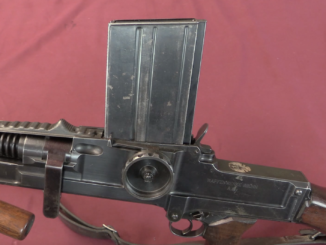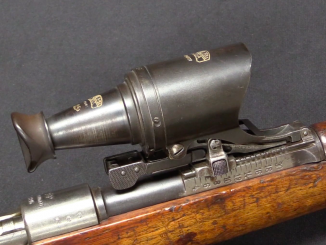The pistol in this video is coming up for auction here.
The Astra 300 was introduced in 1923, copying the layout, mechanics, and handling of the Astra 400 military pistol in a much more convenient pocket size. It was made in both .32 ACP (7.65mm Browning) and .380 (9mm Kurz), with a magazine capacity of 7 and 6 rounds respectively. More than 150,000 were made in total, as the gun was quite popular with various military and security agencies in Spain. The majority of production, however, went to German between 1941 and 1944. They purchased 63,000 Astra 300s in .380 caliber and another 22,390 of then in .32 caliber. Most of the .380s did receive waffenamt markings (WaA251), although not all of them. Production ended in 1945, with the gun being replaced by the improved Model 3000 in 1946.




Simple, reasonable performance for the intended use, and easy to maintain, could one ask for more? I know that the officer’s side arm is not a primary weapon and that it’s more likely a badge of rank. Asking for a side arm capable of putting instantly lethal chest shots 500 meters down range is pretty stupid anyway. At the very least, the compact pistol lets the commanding officer and his adjutant have functioning weapons for use when needed. I can’t imagine any Army colonel screaming “help, help, somebody, save me” if attacked by some lunatic armed with a broken beer bottle. I could be wrong…
Thinking about sidearms changed in effect of experiences of Great War, automatic pistols and revolver proved to be easier to use in cramped trenches than full-length infantry rifles, also ability to fire few bullets (even if it was “small” .32 Auto) in time need to cycle bolt-action repeating rifle was advantageous.
“I do not carry a pistol, my aides do.”
“What if someone tries to assassinate you?”
“I point at him with my stick and say “Kill him.””
“What if he misses?”
“I hit the aide with the stick and say “No, kill HIM.”
“But commandant, what if the assassin shoots the incompetent aide instead of you and then applies for the job of being your aide?”
“It was made in both .32 ACP (7.65mm Browning) and .380 (9mm Kurz), with a magazine capacity of 7 and 6 rounds respectively”
Are magazines different or same for both variants? If first will .32 magazine function in .380 gun, will .380 magazine function in .32 gun?
If .32 shot can be used in .380 magazine, it would add up to versatility. But I am afraid that is not possible because different case dimensions. There is 0.9mm difference in case base diameter (8.6 vs 9.5). Feed lips distance and shape needs to correspond to each particular caliber.
But I understand: U ask if two different magazines can be used in same pistol. That needs some further research…. and may turn into larger project. I would expect frame, which is most labour intensive part, to be the same.
According to https://unblinkingeye.com/Guns/Ortgies/ortgies.html
Ortgies automatic pistol shared common magazines between 7,65 mm Browning [.32 Auto] and 9×17 mm Kurz [.380 Auto] versions, so it is possible to craft magazine working with both of that cartridges.
By the way, common magazines for .32 ACP and .380 ACP: „John Moses Browning had asked »UMC« Thomas of the Union Metallic Cartridge Company to design the .380 ACP in 1907 because Colt wanted a larger, heavier bullet for the 1903 Colt Pocket »Hammerless«. Browning specified that the case length for the new cartridge must be identical to that of the .32 ACP. The idea was that the only modification necessary for the gun to use the new cartridge would be a new barrel and magazine. The .380 barrel for what became the 1908 Colt Pocket »Hammerless« had the same external diameter as the .32 barrel for the 1903 Colt, but a slightly larger bore. When Browning set out to design the Model 1910 FN Browning, he designed it so that only the barrel need be changed to convert from one caliber to the other. The 1910 magazines for the two calibers were identical, even though they were marked 7.65mm or 9mm to match the respective barrels. The magazine holds seven rounds of 7.65mm (.32) or six rounds of 9mm Short (.380).” [https://unblinkingeye.com/Guns/1910FN/1910fn.html] (As far as I know, the magazines of .32 ACP and .380 ACP Frommer 29M and 37M pistols are the same.)
And what about HK-4?
https://modernfirearms.net/en/handguns/handguns-en/germany-semi-automatic-pistols/hk-4-eng/
It was designed as modular, so it can be easy converted between .22 rim-fire, 6,35 mm Browning [.25 Auto], 7,65 mm Browning [.32 Auto] and 9×17 mm Kurz [.380 Auto]. Magazines were marked for their respective calibers, which suggest 7,65 mm and 9 mm to be different, but on the other hand, we have situation description above with magazine marked to “their” calibers in case of FN 1910, but nonetheless being identical.
This little pistol has different slide shape than ubiquitous Browning blowback pistols and that makes it visually distinct. I suppose with this form it has plenty of required mass and thus can be as compact as it is.
I like these little blowbacks be it in .32 or .380 caliber. Recently had chance to examine Walther PP and marveled over every detail of it.
“visually distinct”
In my opinion, it is visually similar to older WALTHER pocket automatic pistols, for example Walther Modell 4, see photos: http://historypistols.ru/blog/pistolety-pod-unitarnyj-patron-avtomaticheskie/raznovidnosti-pistoleta-valter-model-4-walther-model-4/
Fun fact: This Astra pistol can be found very often in older European cartoons (such as Tintins adventures), in the hands of criminals, much like the Tommy gun in US cartoons. If this pistol was particularly easy to get is unknown to me, but it’s high production numbers, wartime use and the situation in the Spanish Civil war make it not unlikely.
One major user of the Astra in 7.65mm was the Luftwaffe, who issued them to aircrews as survival/E&E weapons. This was especially true on the Ostfront; no Luftwaffe airman in his right mind wanted to be captured by the Red Army or Soviet partizans.
Another major issue was to Wehrmacht soldiers in occupied France. When off duty and “on the town”, even in major cities like Paris, Lyon, or Brest, so many were being terminated by the French resistance that they were issued such pocket pistols as these, plus Walthers, FNs, and anything else that could be had, for self-defense.
Lord Haw-Haw excoriated the French over Radio Berlin for their “barbaric” behavior. This resulted in a reply over the BBC Home and Foreign Service by the commander of the Free French Forces, Gen. Charles de Gaulle. Quote;
cheers
eon
“resistance”
Regarding that OSS even developed very special weapon for them:
https://en.wikipedia.org/wiki/Who_Me
however it proved to often also contaminate user, also while it certainly has some morale-damaging effect, I doubt if it would be any significant against men, who might except being killed.
Like the thumb safety. Looks more ergonomic than many.
In regards to the question on using .32 in the .380 magazines,
many,many,many years ago when I was younger and even more foolish than now, I bought and test fired one of these pistols in .32 caliber but found it would not cycle, I could manual cycle the action and it would load and fire. Checking the fired brass cases I found the .32acp cases blown out to .380…….. so, yes it was the wrong caliber, and yes, it will feed .32 out of the .380 magazine….
but the sample size was only 3 rounds.
Great pistols by the way, ended up with them in .32 and .380 and also their father, a 400(which will fire the wrong cartridges happily all day and hit the target)
This is negative side of commonality – risk of firing wrong cartridge, that its .32 Auto in .380 Auto (other way is impossible, as .380 Auto is simply too big to be chambered), so this my explain why FN 1910 magazines were marked only for one caliber – that is to avoid confusion – even if worked with both.
I notice that the slide rests inside the frame rails. Was this pistol particularly accurate?
Note also the fine bright blue finish — I once read that at one time Astra’s bluing was considered superior to Mauser’s.
I just don’t understand the current general disdain for grip safeties — seems to be just the right thing for a cocked’n’locked pocket pistol, especially if you are left-handed and the manual safety is not.
Thanks for showing this item.
“Astra”
It should be noted that in inter-war period in Spain, there were many many many automatic pistol manufacturers, which showed varying levels of quality, Astra was close to “HIGH” end of that scale. To get awareness of multitude of manufactures you might look at drawings available here: http://www.earmi.it/armi/atlas/216.htm
just click Tavola successiva after finishing page, all weapons with code starting with number 37 are automatic pistols from Spain. This is list incomplete.
Some trade names are also curious, see for example 37-32: automatic pistol with own name “Martian” – should this be understand as resident of Mars or it has some other meaning in Español?
A Spanish maker once named a handgun “The Terrible,” meaning terrifying to your enemies, I suppose, rather than low-quality. Maybe “Martian” in Spanish means something like “martial” in English. I just read of a bar fight in Argentina: a native said to an Englishman, “Basta!” (enough), and the Englishman swung at a perceived insult, thinking he’d been called a bastard.
Other name which is mind boggling is Looking Glass, why they decided to use English name and why name in that way?
“seems to be just the right thing for a cocked’n’locked pocket pistol, especially if you are left-handed and the manual safety is not. ”
Keep in mind that after automatic pistols become popular in Europe (1900s) soon many discussions started regarding safeties and how it should looks, that was time of trials (and errors), many solutions were tested including peculiar from our today point of view (cf. Browning Sight Safety), also keep in mind our today requirement “allow safe carry with cartridge in chamber” was not so obvious back then. Various aspects were discussed back then (between 1900 and 2nd World War), like whatever it is better to have magazine safety or to not have it, method of marking lever safety – general practice was to use F for Feuer and S for Sicher, however it was noted if lever safety covers that letters, it is vague for user (wait it is over F so it is ready to Feuer or maybe it is not because S is visible?), also need of grip safety was disputable back then – see for example Star Model A, which lacked that despite it shows some other features of Colt Government.
“left-handed”
I forgot to add, that in 1900s, automatic pistols were supposed to be fired with one hand and always right hand. Question: how to make automatic pistol suitable for use in either hand (without need to crafting “mirror” version of it) is interesting. What do you think about Mauser M2: https://modernfirearms.net/en/handguns/handguns-en/germany-semi-automatic-pistols/mauser-m2-eng/
safety (2nd photo from top)?
Regarding solution available back then, SIG Chylewski might be answer, with it ability to being cycled with one (I presume either) hand [solution later used also in Lignose Einhand], even it was not destined to be hand-agnostic
All pistol manufacturers making .32″ and .380″ACP pistols use same magazine body with minor libs clearance. Astra blowback pistols show great craftsmanship but have some material and heat treatment defects especially at sear and firing pin parts. This model has a two piece firing pin and if gets broken, it would be necessary too take out the extractor first to reach to the firing pin retainer pin.